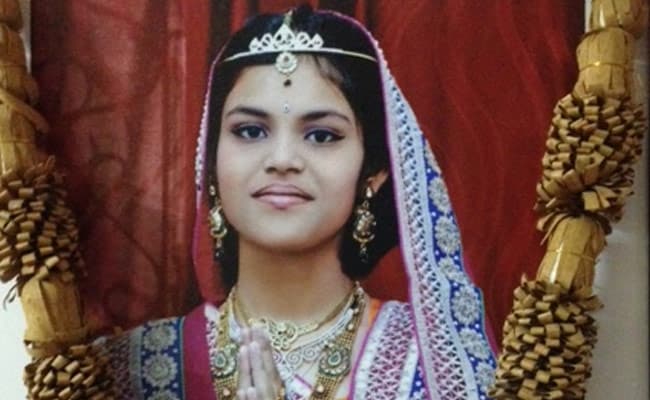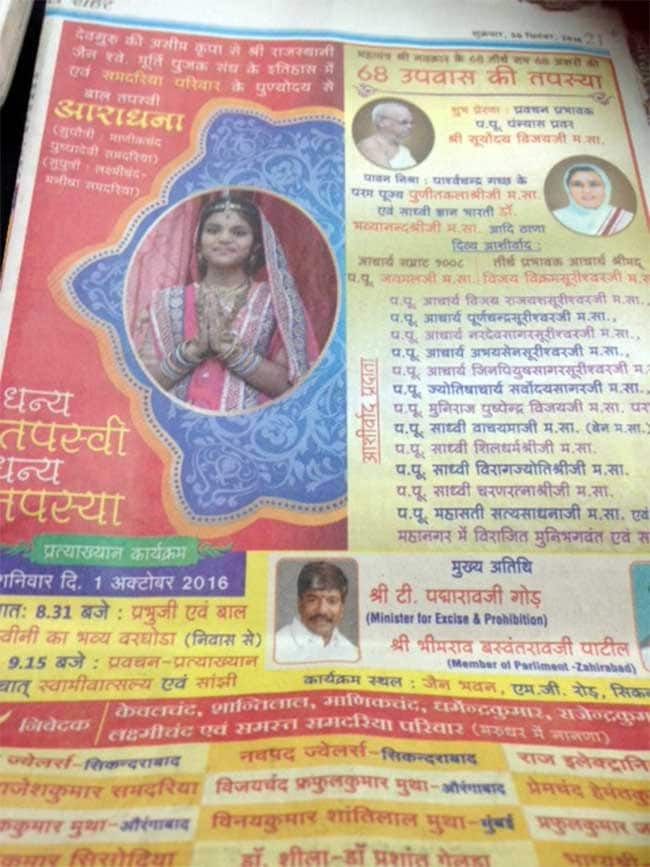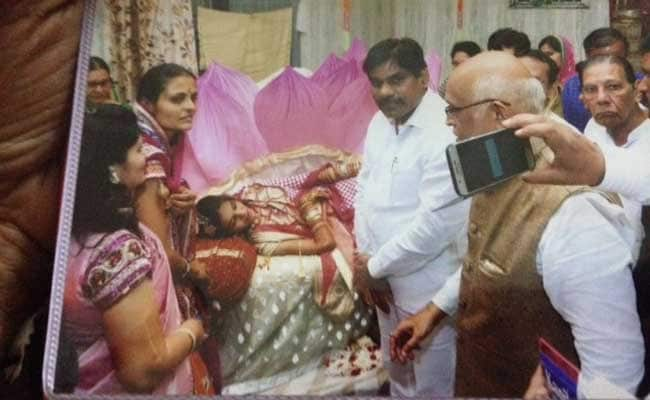
I went to Aradhana Samdariya's house at Pot Bazaar in Secunderabad when the world outside the Jain community had not yet discovered the death of the 13-year-old girl after she completed a 68-day fast.
I did not go as a journalist. I went without a camera, with a friend who belonged to the Jain community to know more about and understand the circumstances that led to her death.
Her father, Lakshmichand, and grandfather, Manekchand, were at the jewellery shop above which the family resides. My friend introduced herself as a social activist (which she is) and told the family we had come to find out what happened. Her grandfather told us the family had every reason to be proud of Aradhana. But of course, they were heartbroken about the girl's death and even more so about a whisper campaign that had started on WhatsApp, blaming the family for Aradhana's death.
Why did you allow her to fast for 68 days, I asked.
"From the age of five, the child was religiously inclined. When she was 11, she asked me for permission to take deeksha (become a monk). I told her, wait till you are 16. Then she asked for permission to do tapas, (penance)'' Manekchand Samdariya said.
 "She was doing fine. In fact, people said even during the shobha yatra (the funeral procession was called shobha yatra, not shav yatra) that her face has the glow of someone spiritual," her father told me. However, when she ended her fast, having survived only on boiled water twice a day for over two months, her weakness was apparent. "We even put her on drip, so she could recover. She usually sleeps around 8 pm. But around 11 pm on 3rd October, she sweated profusely. After wiping her down repeatedly, we took her to hospital. They tried to revive her with oxygen and more, but it was too late,'' he recalled.
"She was doing fine. In fact, people said even during the shobha yatra (the funeral procession was called shobha yatra, not shav yatra) that her face has the glow of someone spiritual," her father told me. However, when she ended her fast, having survived only on boiled water twice a day for over two months, her weakness was apparent. "We even put her on drip, so she could recover. She usually sleeps around 8 pm. But around 11 pm on 3rd October, she sweated profusely. After wiping her down repeatedly, we took her to hospital. They tried to revive her with oxygen and more, but it was too late,'' he recalled.
During our conversation, other relatives gathered to contribute. The sense of pride, of Aradhana having accomplished a remarkable and desirable feat, was uniform. "She has brought pratishta to us, a name in the community,'' an uncle said.
Aradhana's grandfather showed us quarter-page ads in local Hindi dailies about the big public event - a reception - after she completed her 68-day fast. The colourful ad showed Aradhana dressed like a goddess and referred to her as Baal Tapasvi (child saint); it featured a line-up of religious and spiritual gurus who had congratulated her on her achievement. There were also photos of Telangana minister Padma Rao Goud and Zaheerabad parliamentarian BB Patil, mentioned as chief guests. Padma Rao did not attend as he suffered a knee injury but Patil attended the reception, and even posed with an emaciated looking Aradhana, for photographs, as she lay on a couch, too weak perhaps to get up.
 "At that ceremony, some 700 people participated. They all appreciated the girl and our family and even took selfies with her. Now the same people are pointing fingers,'' Lakshmichand said.
"At that ceremony, some 700 people participated. They all appreciated the girl and our family and even took selfies with her. Now the same people are pointing fingers,'' Lakshmichand said.
Aradhana's grandfather also pulled out a file that had letters written by Jain leaders from elsewhere that advised the family not to observe elaborate grieving rituals because they believed the teen had attained moksha (freedom from the cycle of reincarnation)
We asked to meet Manisha, Aradhana's mother, described by those who know her well as a very devout woman. We were led upstairs where Aradhana's grandmother and aunts showed us albums of the Parna ceremony or celebratory reception. They pointed to photos that showed the scale of the grand event, the bedecked chariot on which Aradhana rode along with her parents, the VIPs who had come and clicked selfies. Aradhana's grandmother Pushpa, said Manisha was not willing to meet anyone. In the same room, sat Aradhana's younger sister, just about 8 or 9 years old, quietly watching us. Some younger cousins were playing by her side.
The centerpiece on the wall was a big, framed and now-famous photo of Aradhana all dressed up. "This was taken after she completed her 34-day fast last year,'' we were told. There were other photos, plaques and gifts that showed the honours bestowed on the child. I asked for permission to take photos.
 What surprised me was that two of Aradhana's paternal aunts were introduced to me as doctors - a paediatrician and a gynaecologist.
What surprised me was that two of Aradhana's paternal aunts were introduced to me as doctors - a paediatrician and a gynaecologist.
One said she did not really examine the girl regularly, but "she seemed to be doing fine" as the fast progressed. "After the Parna, I even asked her to read a book and she seemed to be able to do that,'' she said.
"Her fast was voluntary'' was emphasized. But what about the psychological pressure of being put on a pedestal, being revered as someone who is above ordinary mortals? For me, Aradhana's story is about a mere child being deified and trapped by religious conditioning and unrealistic expectations.
Will you allow your younger daughter to undertake a similar fast, I asked, before leaving. She's not like her elder sister but, I don't think so, no, was Lakshmichand's answer.
We broke the story on NDTV the next day. Every other channel and media house, local, national and international followed up. Police cases charged the family with culpable homicide. Some are demanding murder charges should apply.
The police is being circumspect. They are reluctant to arrest the parents or any religious gurus for fear of a backlash from the community. In private, many in the community concede this is time to introspect and not let something like this recur. But in public, all Jains are expected to stand by the family.
Child rights activists say protecting a child is paramount, even if it is from their own parents or religion or community. But as a senior police officer points out, there is self-flagellation as religious tradition in some communities, beating up with sticks in another, piercing of face and body in a third - how much can be done when communities quote the constitutional freedom to practice religious traditions?
(Uma Sudhir is Resident Editor, NDTV)
Disclaimer: The opinions expressed within this article are the personal opinions of the author. The facts and opinions appearing in the article do not reflect the views of NDTV and NDTV does not assume any responsibility or liability for the same.
I did not go as a journalist. I went without a camera, with a friend who belonged to the Jain community to know more about and understand the circumstances that led to her death.
Her father, Lakshmichand, and grandfather, Manekchand, were at the jewellery shop above which the family resides. My friend introduced herself as a social activist (which she is) and told the family we had come to find out what happened. Her grandfather told us the family had every reason to be proud of Aradhana. But of course, they were heartbroken about the girl's death and even more so about a whisper campaign that had started on WhatsApp, blaming the family for Aradhana's death.
Why did you allow her to fast for 68 days, I asked.
"From the age of five, the child was religiously inclined. When she was 11, she asked me for permission to take deeksha (become a monk). I told her, wait till you are 16. Then she asked for permission to do tapas, (penance)'' Manekchand Samdariya said.

13-year-old Aradhana Samdariya died after fasting for 68 days as per Jain rituals during the holy period of 'Chaumasa'
During our conversation, other relatives gathered to contribute. The sense of pride, of Aradhana having accomplished a remarkable and desirable feat, was uniform. "She has brought pratishta to us, a name in the community,'' an uncle said.
Aradhana's grandfather showed us quarter-page ads in local Hindi dailies about the big public event - a reception - after she completed her 68-day fast. The colourful ad showed Aradhana dressed like a goddess and referred to her as Baal Tapasvi (child saint); it featured a line-up of religious and spiritual gurus who had congratulated her on her achievement. There were also photos of Telangana minister Padma Rao Goud and Zaheerabad parliamentarian BB Patil, mentioned as chief guests. Padma Rao did not attend as he suffered a knee injury but Patil attended the reception, and even posed with an emaciated looking Aradhana, for photographs, as she lay on a couch, too weak perhaps to get up.

A quarter-page ad in a local Hindi daily about a reception after Aradhana completed her 68-day fast
Aradhana's grandfather also pulled out a file that had letters written by Jain leaders from elsewhere that advised the family not to observe elaborate grieving rituals because they believed the teen had attained moksha (freedom from the cycle of reincarnation)
We asked to meet Manisha, Aradhana's mother, described by those who know her well as a very devout woman. We were led upstairs where Aradhana's grandmother and aunts showed us albums of the Parna ceremony or celebratory reception. They pointed to photos that showed the scale of the grand event, the bedecked chariot on which Aradhana rode along with her parents, the VIPs who had come and clicked selfies. Aradhana's grandmother Pushpa, said Manisha was not willing to meet anyone. In the same room, sat Aradhana's younger sister, just about 8 or 9 years old, quietly watching us. Some younger cousins were playing by her side.
The centerpiece on the wall was a big, framed and now-famous photo of Aradhana all dressed up. "This was taken after she completed her 34-day fast last year,'' we were told. There were other photos, plaques and gifts that showed the honours bestowed on the child. I asked for permission to take photos.

Zaheerabad lawmaker BB Patil seen posing with the Jain teen
One said she did not really examine the girl regularly, but "she seemed to be doing fine" as the fast progressed. "After the Parna, I even asked her to read a book and she seemed to be able to do that,'' she said.
"Her fast was voluntary'' was emphasized. But what about the psychological pressure of being put on a pedestal, being revered as someone who is above ordinary mortals? For me, Aradhana's story is about a mere child being deified and trapped by religious conditioning and unrealistic expectations.
Will you allow your younger daughter to undertake a similar fast, I asked, before leaving. She's not like her elder sister but, I don't think so, no, was Lakshmichand's answer.
We broke the story on NDTV the next day. Every other channel and media house, local, national and international followed up. Police cases charged the family with culpable homicide. Some are demanding murder charges should apply.
The police is being circumspect. They are reluctant to arrest the parents or any religious gurus for fear of a backlash from the community. In private, many in the community concede this is time to introspect and not let something like this recur. But in public, all Jains are expected to stand by the family.
Child rights activists say protecting a child is paramount, even if it is from their own parents or religion or community. But as a senior police officer points out, there is self-flagellation as religious tradition in some communities, beating up with sticks in another, piercing of face and body in a third - how much can be done when communities quote the constitutional freedom to practice religious traditions?
(Uma Sudhir is Resident Editor, NDTV)
Disclaimer: The opinions expressed within this article are the personal opinions of the author. The facts and opinions appearing in the article do not reflect the views of NDTV and NDTV does not assume any responsibility or liability for the same.
Track Latest News Live on NDTV.com and get news updates from India and around the world

